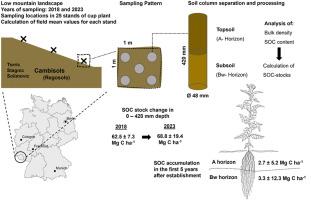Potential C-storage in soils when cultivating the perennial cup plant (Silphium perfoliatum L.) – a field trial study in western Germany
IF 5.8
2区 生物学
Q1 AGRICULTURAL ENGINEERING
引用次数: 0
Abstract
In contrast to other energy crops, cup plant features numerous ecological benefits. Based on the ecophysiology of the cup plant as a perennial and deep rooting crop, a significant potential for soil organic carbon (SOC) accumulation can be assumed. However, such data under practice farming conditions are missing up to now.
A field study was performed on 17 newly established cup plant sites on arable farm land in 2018. They were located in a low mountain range in Western Germany and managed by the respective farmers. Shortly after establishment, soil organic carbon stocks in topsoil and subsoil down to 45 cm depth were determined and repeated five years later in 2023.
Predominantly, increases in SOC stocks could be observed. Annual accumulation rates ranged between 400 kg C ha−1 yr−1 and approx. 1500 kg C ha−1 yr−1. Significant accumulation of SOC was especially observed in the subsoils whereas several topsoils lost SOC. The losses in the topsoil may result from high tillage intensity for seedbed preparation for cup plant establishment in combination with the low aboveground biomass development in the first two years of cultivation resulting in low amounts of aboveground litter. Increases in subsoil SOC indicate for the higher translocation of assimilation products into the root system. Root exudation and root biomass turnover in combination with lower SOC turnover rates in the subsoil likely present the basement for intense SOC accumulation in subsoils under cup plant cultivation.
Our results reveal that the cultivation of cup plant may contribute to climate change mitigation and may further improve soil quality.

多年生杯状植物松香(Silphium perfoliatum L.)土壤潜在碳储量的研究——在德国西部进行的一项实地试验研究
与其他能源作物相比,杯状植物具有许多生态效益。基于杯状植物作为多年生深根作物的生态生理特征,可以推测其土壤有机碳(SOC)积累潜力巨大。然而,到目前为止,在实践农业条件下的这些数据仍然缺失。
本文章由计算机程序翻译,如有差异,请以英文原文为准。
求助全文
约1分钟内获得全文
求助全文
来源期刊

Biomass & Bioenergy
工程技术-能源与燃料
CiteScore
11.50
自引率
3.30%
发文量
258
审稿时长
60 days
期刊介绍:
Biomass & Bioenergy is an international journal publishing original research papers and short communications, review articles and case studies on biological resources, chemical and biological processes, and biomass products for new renewable sources of energy and materials.
The scope of the journal extends to the environmental, management and economic aspects of biomass and bioenergy.
Key areas covered by the journal:
• Biomass: sources, energy crop production processes, genetic improvements, composition. Please note that research on these biomass subjects must be linked directly to bioenergy generation.
• Biological Residues: residues/rests from agricultural production, forestry and plantations (palm, sugar etc), processing industries, and municipal sources (MSW). Papers on the use of biomass residues through innovative processes/technological novelty and/or consideration of feedstock/system sustainability (or unsustainability) are welcomed. However waste treatment processes and pollution control or mitigation which are only tangentially related to bioenergy are not in the scope of the journal, as they are more suited to publications in the environmental arena. Papers that describe conventional waste streams (ie well described in existing literature) that do not empirically address ''new'' added value from the process are not suitable for submission to the journal.
• Bioenergy Processes: fermentations, thermochemical conversions, liquid and gaseous fuels, and petrochemical substitutes
• Bioenergy Utilization: direct combustion, gasification, electricity production, chemical processes, and by-product remediation
• Biomass and the Environment: carbon cycle, the net energy efficiency of bioenergy systems, assessment of sustainability, and biodiversity issues.
 求助内容:
求助内容: 应助结果提醒方式:
应助结果提醒方式:


